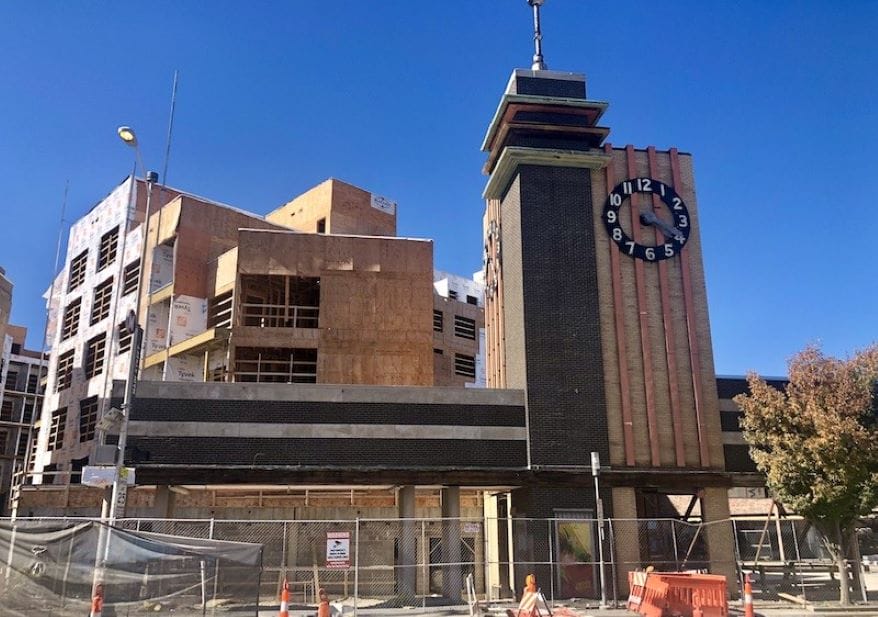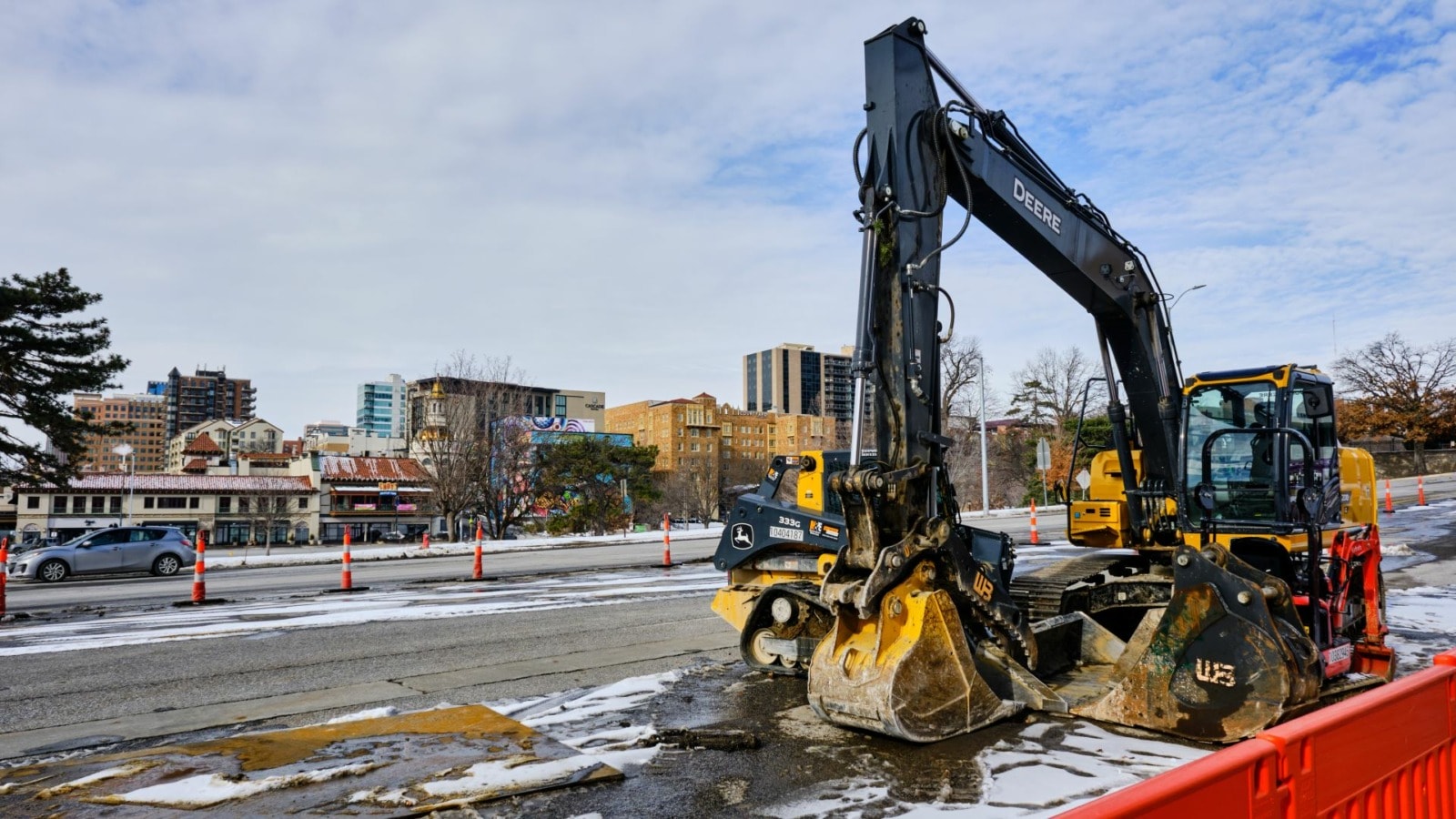Midtown Kansas City Reconnects with Streetcar Roots Will Wave of Development Displace Long-time Residents and Businesses?
Published February 15th, 2024 at 6:00 AM
Above image credit: Work continues on a 16-stop, $350 million streetcar extension that will connect the River Market to the western edge of the University of Missouri-Kansas City by 2025. (Dominick Williams | Flatland)Midtown is going back to the future.
Nearly 70 years after Kansas City shut down its once-thriving streetcar system, old rails serving the streetcars of the past are being unearthed. They are being replaced by a 16-stop, $350 million streetcar extension that will connect the River Market to the western edge of the University of Missouri-Kansas City by 2025.
The long-term impact of the streetcar extension remains unclear.
Advocates point to a string of development projects along the route as evidence that the streetcar extension will serve as a catalyst to fill vacant storefronts and attract residents to plant roots in Midtown.
Others, especially long-term Midtown residents, fret about being priced out and displaced.
Only one thing is certain: Midtown is changing, again.
Flatland in Focus
Lessons of Our Past
Kansas City once boasted one of the largest streetcar networks in the country. That changed in August 1955, when the board of the Kansas City Public Service Co. unanimously voted to sell all 144 streetcars.
The decision coincided with a car-centric, post-World War II suburban boom. It also marked the beginning of a decline in Midtown, which became a drive-through community that lost appeal for many residents and businesses.
For years, pockets of Midtown lost population and suffered from widespread vacancies. Kevin Klinkenberg, executive director of Midtown KC Now, believes the streetcar extension could bring the neighborhood back to its former glory.
“I think (the streetcar) breeds a sense of optimism in the city that we haven’t always had,” Klinkenberg said. “Even though it’s a challenge to work through the construction process, I think most people are really excited and optimistic for what this means for this part of the city.”
Midtown KC Now and Ride KC are collaborating to improve the neighborhood by identifying opportunities for affordable housing and businesses to succeed. The new streetcar extension provides a framework for those discussions.
“One of the reasons why, as a region, we haven’t made progress is because we haven’t built consensus at a community level around what our vision is for Kansas City in 2026, let alone 2050,” said Tom Gerend, executive director of the KC Streetcar Authority. “We’ve been very focused on the Midtown corridors and the vision these neighborhoods have for themselves and how transit is connected. We want our transportation investment to have long-term value.”
For decades, the region turned its backs on the urban core to invest in its suburbs and Kansas City paid the price by losing its residents, Gerend said.
“It’s going to take time rebuilding the population base in Midtown. Then and only then will we get back to what made this one of the most successful and desirable neighborhoods,” Klinkenberg said.
Midtown neighborhoods in 1950 were home to 73,000 people. Today, only 28,000 remain. Midtown KC Now believes the streetcar will help the area return to its prime.
Back in the day, Kansas City homes were built around transit and Klinkenberg thinks Midtown will gradually return to that development pattern.
“Now over 70 percent of Midtown residents voted to ultimately tax themselves to help financially support the extension because they see the power in that service,” Gerend said. “They see what it’s done downtown, bringing people on the street supporting existing local businesses and making it easier for people who want to live car free or car light with a reliable, high-quality option.”
The extension fundamentally changes the function of the current streetcar route by connecting the two largest job centers in the city through the densest residential neighborhood.
“We’re going to be the spine of a multimodal system that’s connected to bus routes to Johnson County and east-west routes,” Gerend said.
The streetcar acts as a great stabilizing force for investment in the area because it also gives future residents a transit option that doesn’t require parking, Klinkenberg said.
“The streetcar acts as a great amenity… Developers know that people will want to be there. And are willing to invest in bigger, more expensive projects to do that,” Klinkenberg said.
Considering that the current streetcar line spans just two miles downtown, Klinkenberg thinks it’s too early to attribute rising rents in Midtown to the streetcar itself. The area instead will see a gradual increase as the extension will pass through an already established neighborhood, which is a major difference between Midtown and downtown.
“I think we will eventually see (rent increasing in Midtown). I just don’t think we’ve seen it yet,” Klinkenberg said.
Census data from 2017 shows the median rent in Westport was $798. In 2020, that same census tract was split into two with the median rent jumping to $1,199 and $1,552, respectively. But it’s hard to say whether the extension is directly correlated to the spike in price point.
Pains of Our Present
John Owens grew up near 32nd Terrace and the Paseo in the 1970s. He remembers when Midtown was a lively, diverse neighborhood where everyone knew each other.
He also remembers families moving to the suburbs and homes and businesses being torn down to make way for progress and new development.
In the past decade, the BIPOC population in Midtown has declined in some census tracts.
“I’ve noticed that more people of color have been out of Midtown more than anything. When I first came here… every nationality was here in (the) Midtown area,” Owens said. “You walk up and down Armour, and you rarely see Asians, you rarely see African Americans around here anymore… It’s different. The whole culture has changed because people can’t afford to live here.”
Gabe Coppage, another long-term resident of Kansas City, said this change isn’t a coincidence.
“Poor people and Black people that have found community and home in this historically affordable neighborhood are now having to figure out where they’re going to live,” Coppage said. “That’s the biggest question: Where are we supposed to go if rent keeps going up but there’s no affordable options in the neighborhood?”
Coppage has lived in the neighborhood for more than 11 years. He always viewed Midtown as a haven for artists that bustles with a vibrant, lively culture. Currently, Coppage is a KC Tenants organizer and leads the Midtown Tenants Union.
“We’ve seen rents skyrocket with all the recent developments,” Coppage said. “I don’t think conditions have improved necessarily of the apartments that are available because of the market. I feel like developers have caught on to Midtown being a ‘hip, cool’ neighborhood or that’s what they’re trying to turn it into and raising rents accordingly to that. It’s pretty much impossible to find an apartment that’s like under $1,000.”
“We’ve seen rents go up across the board for all kinds of housing because we’re in a part of the city that has become more desirable quickly,” Klinkenberg said. “People have to remember that rent was extraordinarily cheap in Midtown because people didn’t want to live here, and owners weren’t making enough money to be able to keep up the buildings.”
As more buildings in Midtown are renovated and upgraded, landlords will charge more to tenants who have enough to pay more.
“Housing is never static,” Klinkenberg said.
“A lot of what is being built is not for people that live in Midtown,” Coppage said. “Out-of-state developers weave the narrative that they’re ‘saving’ a part of the city but all they’re interested in is their bottom line.”
Caleb Buland, an architect for Exact Partners, counters that perception.
Rents on the firm’s projects start under $1,000, because the firm structured the projects to keep the costs affordable.
“Everything’s better if we try to begin with the end in mind,” Buland said.
The firm works with various city, state and federal agencies offering incentives to reduce the cost of redeveloping empty historic buildings, which makes rents more affordable for tenants.
“It’s important to meet with the neighborhood before you start construction and find out the type of product they want, what their costs are, and what they’d like their cost to be,” Buland said. “If it’s possible to deliver exactly what somebody wants, you’re going to have a project, that’s a huge win for the city. We try to design better buildings that cost less money to operate and result in fewer charges going to tenants, which means lower rent.”
Delivering attainable or affordable housing takes either skill or luck since there are a lot of different paths to find the right incentives, Buland said.
“Experience helps a lot because the city staff, the state staff are open to helping, but you certainly have to know how to get down the right path, know your costs and be willing to commit to 20-30 years to see it through,” Buland said.
“There are some agencies that just can’t work through that. It becomes a process of matching up the goal with the agency and then putting the information together with professionals, the CPAs and the other people who study affordable housing, those consultants so that you can get to the outcome you need. We’ve gotten good at that and wrapping construction in 12 to 14 months.”
On Jan. 26, Kansas City officials passed an anti-discrimination law which requires landlords in Kansas City unable to reject a potential renter solely based on how they pay rent. This includes Section 8 housing vouchers and other forms of government aid. The law will go into effect in six months.
Kansas City now joins 85 cities, 21 counties and 17 states that have banned “source of income” discrimination. Research has shown the practice disproportionately impacts people of color, particularly Black renters, by making it more difficult for them to obtain housing.
Developers Versus Residents
Although KC Tenants supports its poor and working-class tenants who depend on public transit, Coppage said the organization is wary that the streetcar extension is not designed with those folks in mind.
“It’s catering more to folks trying to use Midtown, downtown as a playground,” Coppage said. “When the city approved the streetcar extension it notified developers that there’s a lot of potential opportunity here and now we’re seeing a lot of development proposals for luxury apartments along the route that have already effectively priced out tenants in the neighborhood.”
Coppage pointed to the former Katz building on Westport Road as an example of a development that has priced people out of the neighborhood. The building, which previously housed art studios, was sold to a St. Louis developer who is turning it into luxury apartments.

“The biggest thing is that they’re not building those developments for people that already live here. They’re looking to bring in people with a higher tax bracket,” Coppage said.
A policy brief addressed to the City Council examined the impact of the streetcar extension on the low-income households and provided strategies to mitigate the displacement of low-income households along the extension.
The brief, sent from planner Ben Schnelle in 2022, states that census tracts within a half mile of the line have seen a greater increase in median rent and a greater decrease in the Black population, bus commuters, population below the poverty line, and rental units than citywide.
The Midtown Tenants Union came together when Mac Properties, a Chicago-based developer that owns many properties along Armour Boulevard, proposed a development coined 1 W. Armour.
The project involves renovating the existing US Bank building that sits at the intersection of Main and Armour. It also called for the construction of a 10-story apartment building in three segments along Main, and a nine-story apartment building on Armour.
Also found at the development site are the New Yorker Apartments. Historically, those apartments were a haven for those in need of affordable housing, Coppage said.
Initially, Mac Properties sought tax incentives for the development — though none of the planned units were designated as “affordable”. In January 2023, the City Council rejected Mac Properties’ request for tax incentives a second time, following pressure from entities like KC Tenants.
“About a month after they didn’t get their tax break to build this development, all the tenants at the New Yorker were actually issued a building-wide lease non-renewal,” Coppage said. “So, they were all given letters on their door that they had to be out in the next 30 days, or their rent was going to increase by 150 percent.”
Before the incentive denial, Mac had signaled an aim to break ground on 1 W. Armour in the summer of 2024, complete the project in late 2025 and achieve lease-up and retail occupancy through 2026.
Owens was one of the New Yorker tenants forced to relocate.
Owens said he and the other former New Yorker tenants have been moved to Park Central. They also have been contacted by Mac that rent will increase anywhere from $100 to $200. He pays $852 and was notified his rent would increase by $440.
He is now looking at a trailer community in Independence because he wants room for his grandchildren to play. He’s considering paying $900 for a two-bedroom trailer. He receives $13,000 a year from Social Security.
“This is my home. And I feel like I’m being run out of it… That’s exactly what’s going on. I’m being run out,” Owens said. “Midtown is my home so (leaving) is going to be heartbreaking, but you have to do what you have to do.”
“There needs to be a way for the city to invest in truly affordable housing or figure out solutions for permanently affordable housing rather than investing in tourism, like the streetcar, the World Cup or the potential stadium,” Coppage said. “Those are not necessarily things that prioritize the needs of the poor, working class people in this city.”
Coppage said KC Tenants is not anti-public transit or anti-development, but said they are anti-displacement.
As of 2022, Kansas City defines affordable as 60% of the area median income (AMI) based on the United States Department of Housing and Urban Development (HUD) definition of the metro’s median income.
“How the city calculates affordability is a problem and something that we’ve tried to address because when developers are building ‘affordable units.’ Who are those units affordable for?” Coppage said.

Building Our Future
“There’s lots of different types of housing and we need all of it,” Klinkenberg said. “New construction appeals to people who can afford to pay more, but we also need all other forms of housing to accommodate residents across the spectrum. Our goal is trying to figure out how can we help developers provide that housing and get as much of it as we can, so that we can soak up the demand for housing.”
“Diverse housing and diverse businesses are what make our communities vibrant, and resilient,” said Shawnna Murrell. “By offering a range of housing options as well as commercial spaces, then we can ensure that Midtown is accessible for all people — whether it’s student housing, rental housing or for low-to-moderate income families.”
Murrell, owner and managing broker of Murrell Homes Real Estate Group, sees the streetcar as an opportunity to bring life to the businesses of Midtown and as a magnet for future homeowners.
She grew up in the area and followed her father’s entrepreneur footsteps, locating her business at the heart of Midtown at 39th and Main — the same street where her father’s auto mechanic shop was located.
“Everyone in Midtown, from neighbors to business owners, is very helpful and happy to speak to you,” Murrell said. “I don’t think that that’s changed or going to change from how it used to be. Midtown has been very intentional with keeping (its culture) and ensuring that small businesses feel that have support here.”
Nicole Dolan is a freelance reporter assisting with “Flatland in Focus” on Kansas City PBS. Julie Freijat, a masters student at the University of Missouri and a Flatland contributor, assisted with visualizations. Cody Boston is a multimedia producer for Kansas City PBS and the producer of “Flatland in Focus.”





